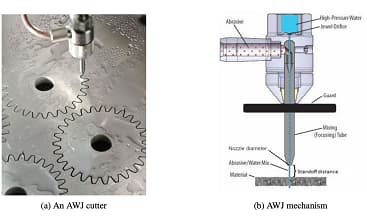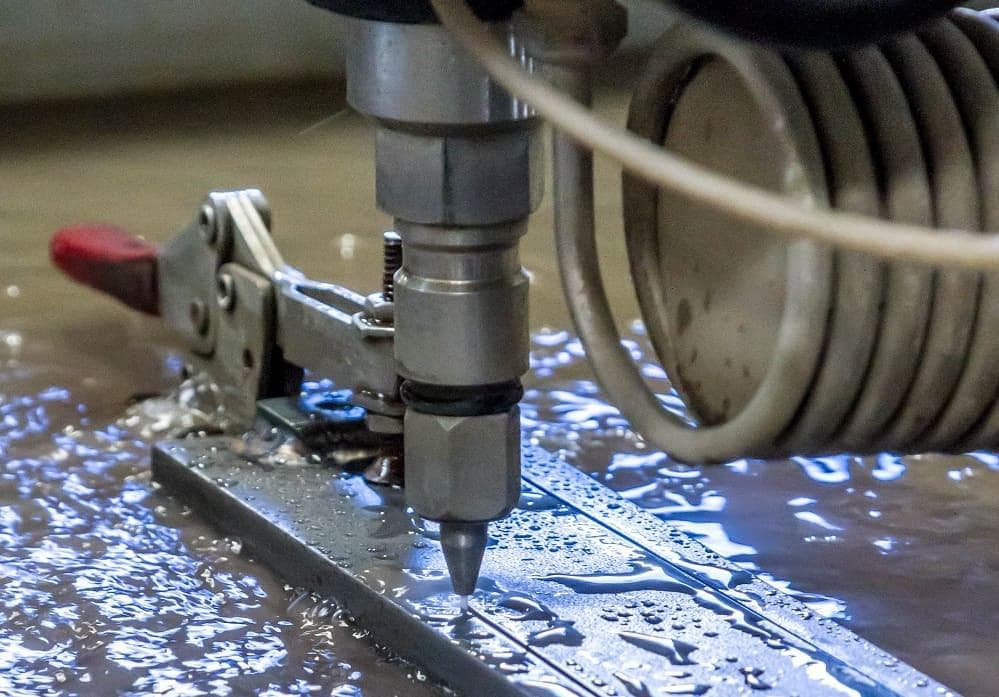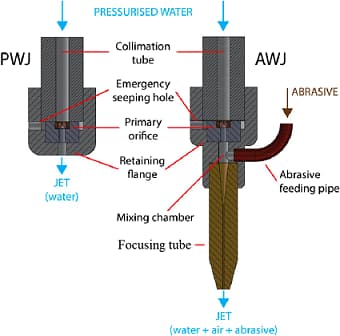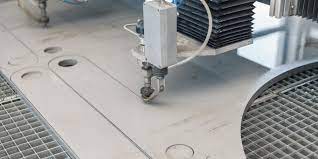When it comes to cutting materials, abrasive waterjet cutting vs pure waterjet cutting are two popular methods. Both techniques use high-pressure water to cut materials, but differ in how they do it. Abrasive waterjet cutting uses abrasive material to cut, while pure waterjet cutting only uses pressurized water.
It’s important to consider the differences between pure and abrasive waterjet cutting when deciding between them. Factors like the materials, precision requirements, applications, and operation costs will all play a role in determining the best option for your project.
This article will compare the advantages and disadvantages of abrasive vs pure waterjet cutting to help you decide which is best for your project.
Abrasive Waterjet Cutting
Abrasive waterjets use diamond abrasives with high pressure to cut through metals, plastics, composites, and other materials. Some abrasive particles injected into pressurized water at high speeds break into micro-particles. Micro-particles have a larger surface area and can penetrate deeper into surfaces, increasing wear resistance on tooling and components.

Pure Waterjet Cutting
Pure waterjet cutting is a newer form of waterjet cutting that has gained popularity over the past decade or so. This method uses only pure water in its cutting process, instead of adding abrasive material like garnets or other types of abrasives. Pure waterjet cutting produces less heat and can be used on sensitive materials without damaging them.

Differences Between Abrasive vs Pure Waterjet Cutting
Process
In the abrasive waterjet cutting process, sand or garnet grit is used as an abrasive agent. Grit fed into the cutting head at high pressure creates high temperatures and pressures. High-speed water streams and abrasive material create a powerful jet that can cut through any material.
Pure waterjet cutting uses no abrasives whatsoever in its process. Instead, it relies on sheer force and pressure generated by the high-speed stream of water to cut through materials such as metal or stone without damaging their surface finish or integrity.
Materials
Another difference between abrasive and pure waterjet cutting is materials. Abrasive waterjets can cut a variety of materials. Grinding is necessary before use to avoid damaging the equipment or operator.
The cost of replacement abrasives can add up quickly over time, especially if you’re using a large-scale machine that runs for long periods of time. Pure water jets may not work with all materials equally well, so it’s important to check compatibility before using them.
Precision
Abrasive waterjet cutting can achieve high precision using a sharp, high-speed steel wire. It can cut through hard materials like stainless steel and titanium without damaging them. The high pressure required for this process also helps produce very precise cuts even when working with thick sections of material at high speeds.
A fine beam of high-pressure water, created by focusing the waterjet with a lens, gives pure waterjet cutting its precision. High-speed water beam cuts intricate shapes without damaging the surrounding area.
Application
The industry mainly uses abrasive waterjet cutting, while commercial projects often use pure waterjet cutting.
- Abrasive Waterjet Cutting: Applications include metal fabrication and sheet metal fabrication where holes need to be cut into metal components to make them stronger or reduce weight.
- Pure Waterjet Cutting: Applications include stone cutting, concrete cutting, and glass etching.
Operation Costs
Abrasive waterjets use abrasive particles that need to be replenished periodically. The cost of replacement abrasives can add up quickly over time, especially if you’re using a large-scale machine that runs for long periods of time.
Pure waterjet cutting uses pressurized tap water, so there are no extra costs for consumables or replacement parts like abrasives or coolant.
Learn more about waterjet cutting costs.

Comparing Abrasive and Pure Waterjet Cutting, Which One to Choose
Advantages of Abrasive Waterjet Cutting
Ability to cut harder materials
With the help of the abrasive material, abrasive waterjet cutting can achieve much higher precision and accuracy when cutting harder materials such as metals, stone, and composites.
Faster Cutting Speeds
Because the abrasive material is propelled at high speed, abrasive waterjet cutting can achieve much faster cutting speeds than pure waterjet cutting.
Greater Precision
Abrasive material allows for more precise and accurate cuts through hard materials. This also makes it ideal for creating intricate cuts and working in cavities, as the abrasive material will follow the contours of the workpiece.
Cost-Effective
Abrasive waterjet cutting is a cost-effective cutting method, compared to pure waterjet cutting. Abrasive waterjet cutting uses an abrasive material and high-pressure water to cut through hard materials like metal and stone. This makes it ideal for industrial projects, where precision and accuracy are of the utmost importance.
Easy to use
Abrasive waterjet cutting can be operated using a control panel, making it easy and efficient.
Disadvantages of Abrasive Waterjet Cutting
More Expensive than pure waterjet
Although waterjet cutting is more cost effective than other techniques, there are still some capital and operational costs involved. In the case of abrasive waterjet cutting, the costs become even more significant. Using an abrasive material increases the cost of waterjet technology, making it more expensive than pure waterjet cutting.
Increased Wear and Tear
Due to the added stress caused by the abrasive material, there is increased wear and tear on the equipment used for abrasive waterjet cutting. This can lead to more frequent maintenance and replacement of parts over time.
Health and Environmental Concerns
Abrasive materials can be hazardous to health and the environment. When using these materials, special precautions must be taken to prevent contamination or exposure.
Advantages of Pure Waterjet Cutting
Cheaper Alternative
Pure waterjet cutting is a much cheaper alternative to other cutting methods, due to its lack of a mixing process and minimal setup costs. It is also faster than other cutting methods since there is no need for a mixing process.
Cold cutting
Pure waterjet cutting is a cold-cutting process, so it doesn’t create heat-affected zones. This allows for greater precision and accuracy when working with delicate materials such as composites and plastics.
Precision
Pure waterjet cutting is precise with a low kerf width and won’t damage the workpiece. Intricate cuts can be made in cavities or curves using it, and they can be used to cut any type of soft, light, thin, or delicate material.
Ease of Use
Pure waterjet cutting is automatic and can be operated with a computer program, making it efficient. The right pure waterjet technology and the high-pressure stream can be incorporated into the production.
Disadvantages of Pure Waterjet Cutting:
Slower
Pure waterjet cutting is slower than abrasive waterjet cutting, so it’s not ideal when time is a factor.
Limited Materials
Pure waterjet cutting is limited to soft materials due to its slow cutting rate. This method can cut materials like foam, rubber, wood, aluminum, and some plastics. However, pure water jet cutting becomes infeasible when cutting hard materials because of the extremely slow cutting rate.

Choose the Right One for Your Project
With both abrasive vs pure waterjet cutting, there are limitations on the thickness of the material that can be cut. This is because of the physical properties of the cutting process.
In abrasive waterjet cutting, a lubricant, mixed with water and an abrasive powder, acts as a lubricant for the blade. As the blade cuts through a piece of material, this abrasive mixture scours away material from the surface of your part and leaves behind a smooth finish. This process works well for materials like plastic, rubber, and foam but not so much for metals or other hard materials.
Pure waterjet cutting involves no abrasive mixture in the process at all. Instead, pure water flows through a nozzle under pressure and cuts through your part using sheer force alone. This process works well for metals but not so much for plastics or other soft materials because it tends to melt them instead of cutting through them cleanly.
More Resources:
- Waterjet Cutting vs Laser Cutting: Which Is Better
- Waterjet Cutting vs Plasma Cutting: What Are Their Differences
Conclusion
Both abrasive and pure waterjet cutting have their pros and cons to consider before deciding which is best. Ultimately, it’s essential to find a waterjet company or method that fits your needs. The goal of any waterjet cutting service is high quality results, and RapidDirect provides rapid turnaround times and precise cuts.
RapidDirect offers on-demand waterjet cutting services for your manufacturing needs. We offer precision waterjet cutting services for prototyping and high-volume production with the best results and no additional worries!


